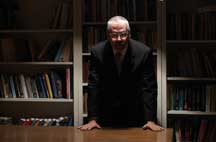More in academe
Environmental warriors | Is this man lying? | Myths behind the blackboard | Sun, moon and culture | Selling from the heart | Uplifiting art |

Is this man lying?
It's all in the eyes, says psychology professor and international
deception researcher Charles Bond, whose work shines a light
on the most common beliefs about fibbing.
By Rick Waters '95

 Can a person really tell when someone is lying? Mothers of trouble-making toddlers may disagree, but the truth is we humans simply can't tell. Can a person really tell when someone is lying? Mothers of trouble-making toddlers may disagree, but the truth is we humans simply can't tell.
Even though we've been communicating for thousands of years, we're statistically terrible at detecting untruths. In hundreds of laboratory studies, participants distinguish correctly between truth and lies only slightly more than 50 percent of the time. This success rate is basically the same for police officers, too.
And liars aren't any better -- successfully fooling guessers about half the time.
In other words, human accuracy is just barely better than chance.
But psychology professor Charles Bond says a better question is how can we tell. What stereotypic behaviors do we associate with fibbing? Shifty eyes? Nervous twitches? Repeated touching of the face or arms? Stammering speech?
Well, people believe all these, but especially lack of eye contact. In two soon-to-be-published reports -- the only ones of their kind in the world -- Bond and a team of 90 scientists studied what almost 5,000 people in 75 countries and in 43 languages believe about liars.
Their conclusion: From the United States to Africa to the South Pacific, a dominant cross-cultural norm exists -- people believe that liars avert their gaze. "This is the most prevalent stereotype about deception in the world,
Bond said.
Yet gaze aversion, like other commonly held beliefs about liars, is not correlated with lying at all, other studies have shown. Psychologists have done experiments in an attempt to describe differences between the behavior of liars and of people telling the truth, and the results are clear: There is no telltale signal for a fib. Liars do not shift around or touch their noses or clear their throats any more than truth tellers do.
"Pinocchio's nose just doesn't exist,
Bond said. "For some, it could be natural behavior. But what is interesting is that people who act in this fashion are often judged to be deceptive whether they are or not.
Just how prevalent are these stereotypes?
In one of the studies, Bond and other researchers asked 20 men and 20 women of 58 countries the open-ended question, "How can you tell when people are lying?
The study generated more than 11,000 responses, which researchers narrowed to 103 distinct beliefs. Women gave slightly more responses than men.
Almost two-thirds of respondents said liars try to avoid eye contact. Next highest was that liars are nervous at 28 percent. "The prevalence of the gaze aversion answer was overwhelming, more than twice of the second-most given stereotype,
Bond said.
A fourth of respondents said that deceptive remarks are incoherent and that lying can be detected from movements of the liar's body. Also common are the beliefs that facial expressions, inconsistencies, speech fillers (such as umms and uhs), facial color and frequent pausing were signals of untruths.
Bond and his team also analyzed the order in which response were given. "Theoretically, the strongest, most accessible beliefs should be mentioned first,
he said.
Nearly 44 percent gave gaze aversion as their number one answer. Other popular first responses included references to the liar's eyes, facial expressions and the belief that one has to know a person to detect lies.
"Interestingly, across 58 countries, less than 1 percent made reference to group membership, such as political party or profession,
Bond said. "Very few commented about a specific situation or incentive to lie.
A second study added more countries and respondents and posed direct questions, such as "When people are lying, they act calm, nervous or neither.
Again, the most popular belief included gaze aversion. More than 71 percent said that liars make less eye contact than truth tellers.
Almost two-thirds said that liars shift their posture more than usual and touch their body more often, while 62 percent believe liars' stories are longer than usual.
"To some, this seems like obvious information, but the fact that an overwhelming majority across 75 countries and in more than 40 languages answered 'gaze aversion' makes it statistically significant,
Bond said. "It appeared in both open-ended descriptions and directed questionnaires responses.
However, he cautioned that beliefs about lying are not intended to be descriptions of liars.
"Instead, they embody societal norms against lying. Stereotypes about lying are meant to discourage lies,
he said. "It's part of our folklore, almost a moral code: we should be ashamed when we lie, liars should feel bad. Lying should not pay. Liars should be caught.
An example is in child rearing. Parents teach children to admit dishonesties because they can't always watch every behavior. The ultimate goal is to instill the accepted behavior of telling the truth, and part of that is for parents to convince children that they will know a lie based on behavior.
"A child learns that they shouldn't lie because Mom will know anyway,
he said.
She can read all the signals.
Contact Bond at c.bond@tcu.edu
Comment at tcumagazine@tcu.edu.

|



